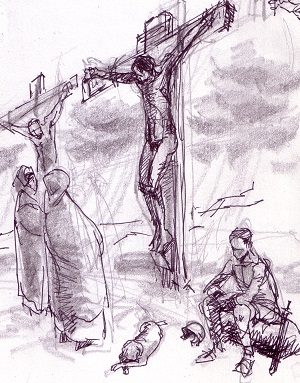

"Jesus’ father and mother were amazed at what was said about him” (Luke 2:33).
Our Lady of Sorrows
1 Tim 3:14-16; John 19:25-27 or Luke 2:33-34
Today’s feast celebrates the suffering of Mary as a mother. Like the Sorrowful Mysteries of the Rosary, we are invited to see the events of the life of Jesus through Mary’s eyes and heart. Today’s Lectionary offers two Gospel scenes as examples of her suffering, one in the temple when Simeon predicts her future suffering and the other at the foot of the cross.
Both scriptural moments in her life would have brought intense suffering to any mother, the first as a shadow falling over her entire life from the moment of Simeon’s prophecy. The beautiful, innocent child she and Joseph have brought to the temple to present to God is to be a sign of contradiction and the cause of the rise and fall of many in Israel. Furthermore, a sword of sorrow will pierce her heart. What mother could bear such a prognosis? Perhaps the thousands of mothers told each year that their child has an incurable disease. To suffer in advance and from anxiety is perhaps the worst kind of suffering.
Standing at the cross, Mary becomes a helpless witness to the torture and death of her beloved son. All she can do is be there and suffer along with Jesus. Scott Wright, a peace activist who accompanied people fleeing into the hills pursued by American-supplied helicopter gunships and Salvadoran soldiers sent to hunt them down during the civil war there, describes the worst suffering of all. It is to be with people in mortal terror and be totally helpless to stop it, he wrote. He compared it to standing at the cross and watching Jesus die, unable to do anything. Again, how many parents of sick children have prayed to exchange places with them in a hospital but have been unable to do anything except witness their pain?
The fourth Gospel’s emphasis on the divinity of Jesus is perhaps reflected in the detail of calling his mother “woman” as he entrusts her to the Beloved Disciple. Would this also have been part of the sword of sorrow she endured, knowing her son was transcending his human relationship to her as he prepared to return to his heavenly Father? The theological intent of the Gospel cannot hide the personal anguish Mary must have faced. Yet this prepares us as disciples to understand that our relationship with Jesus also draws us into the same contradiction and suffering.
By this feast, Mary invites us to ponder the Incarnation, the mystery of God’s entry into the human condition in the person of her son, Jesus. No aspect of human suffering and loss is spared in both their journeys on this earth. They are with us in both the long-term anticipation of pain and the direct confrontation with it as part of being human, including the experience of death. No wonder Mary is designated in the Hail Mary as the one who promises to be with us and praying for us at the hour of our death.
Advertisement






